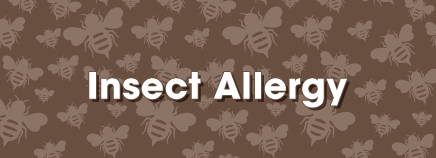
About Insect Sting Allergy
Insect stings usually are minor annoyances. But they can cause serious and sometimes even deadly reactions in kids who are allergic to them.
Insects that can trigger allergic reactions include honeybees, yellowjackets, hornets, wasps, and fire ants. When they sting, they inject venom into the skin.
Allergic reactions to stings usually don’t happen when a child is stung for the first time, but rather when the child is stung for a second time, or even later.
If your child has been diagnosed with an insect sting allergy, keep injectable epinephrine (a medicine that your doctor can prescribe) on hand in case of a severe reaction. Share emergency plans with anyone who cares for your child, including relatives and school officials. Also consider having your child wear a medical alert bracelet.
Talk with your child’s doctor about seeing an allergy specialist to discuss the possibility of allergy shots. These can help the body react less to insect venom, which can make a serious reaction less likely.
If you think that your child might have had an allergic reaction to an insect sting, call your doctor, who can help you understand the difference between a typical reaction and an allergic reaction. The doctor also can see if an insect sting site is infected, which requires different treatment than an allergic reaction.
If the doctor thinks your child might have an insect sting allergy, you’ll probably be referred to an allergy specialist for testing.
What Happens in an Insect Sting Allergy
When someone is allergic to insect stings, the body’s immune system, which normally fights infections, overreacts to proteins in the insect’s venom. When stung, the body sees these proteins as harmful invaders.
The immune system responds by working very hard to fight off the invader. This causes an allergic reaction, in which chemicals like histamine are released in the body. The release of these chemicals can cause someone to have these symptoms:
- wheezing
- trouble breathing
- coughing
- hoarseness
- throat tightness
- stomachache
- vomiting
- diarrhea
- itchy, watery, or swollen eyes
- hives
- red spots
- swelling
- itching
- a drop in blood pressure, causing lightheadedness or loss of consciousness
If a stinger remains in the skin, use your fingernail or a credit card to scrape the stinger from the skin. Removing the stinger quickly can help prevent more venom from going into the body. Don’t use tweezers because they can cause more venom to be released.
Anaphylaxis Is a Life-Threatening Reaction
Insect sting allergies can cause a severe reaction called anaphylaxis. Anaphylaxis can begin with some of the same symptoms as a less severe reaction, but these can quickly become worse, leading someone to have trouble breathing or to pass out. Anaphylaxis that’s not treated can be life-threatening.
If your child starts having serious allergic symptoms, like swelling of the mouth or throat or difficulty breathing, give the epinephrine auto-injector right away. Every second counts in an allergic reaction. Then call 911 to take your child to the emergency room. Your child needs to be under medical supervision because even if the worst seems to have passed, a second wave of serious symptoms often happens.
An epinephrine auto-injector comes in an easy-to-carry container about the size of a large marker or a smartphone. It’s simple to use. Your doctor will show you how to use it. Kids who are old enough can be taught how to give themselves the injection.
School staff should know that your child has an insect sting allergy. Together, agree on a plan in case of a serious reaction at school, including making sure that injectable epinephrine is available at all times. If your child is old enough to carry the epinephrine, it should be in a purse or backpack that’s with your child at all times, not in a locker.
Your child’s allergy plan also could include giving an over-the-counter antihistamine for milder allergy symptoms. But the antihistamine should be given after the epinephrine in the case of a serious, life-threatening reaction.
Insect Sting Allergy Safety Tips
The best way to prevent allergic reactions to insect stings is to avoid getting stung in the first place. Teach your child to:
- Avoid walking barefoot while on the grass.
- Avoid playing in areas where insects like to be, such as flower beds.
- Avoid drinking from open soda or juice cans and be sure to keep food covered when eating outside. Check for insects in drink cups and straws when outside.
- Remain calm and quiet around stinging insects. Moving slowly, back away without any arm-waving or swatting.
- Never disturb an insect nest. Have an exterminator get rid of nests near your home.
- When in wooded areas, keep as covered up as possible. Long-sleeved shirts, long pants, socks, and closed-toe shoes can help keep the bugs away. (Loose clothing can allow insects to get between the clothes and skin.)
- Avoid perfumes, scented body products, and brightly colored and flowered clothing because they all attract insects.

